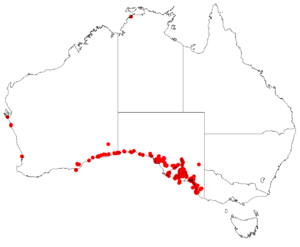Tea-tree mistletoe facts for kids
Quick facts for kids Tea-tree mistletoe |
|
|---|---|
| Scientific classification | |
| Genus: |
Amyema
|
| Species: |
melaleucae
|
 |
|
| Collections data for A. melaleucae from the Australasian Virtual Herbarium | |
| Synonyms | |
|
Amyema leschenaultii Tiegh. |
|
Amyema melaleucae, also known as the tea-tree mistletoe, is a type of flowering plant. It belongs to the genus Amyema and the family Loranthaceae. This plant is special because it is a hemiparasitic plant. This means it grows on other plants and takes some water and nutrients from them, but it can also make its own food using sunlight.
The tea-tree mistletoe is native to Australia. You can find it along the coast in Western Australia and South Australia. It grows from areas north of Perth almost all the way to the border with Victoria.
Contents
What Does It Look Like?
The tea-tree mistletoe is a plant that stands upright. It has a single special root-like part called a haustorium. This part helps it attach to its host plant.
Leaves and Flowers
Its leaves are narrow and shaped like a spearhead. They are usually 20 to 45 millimeters long and 2 to 4 millimeters wide. Sometimes, they can be up to 7 millimeters wide. The leaves do not have a stalk (called a petiole) and are rounded at the tip.
Unlike many other Amyema plants, the flower bud is smooth. The flowers grow in groups of three, called triads. These triads are arranged on a stalk, which is known as a peduncle. The middle flower in each group does not have its own small stem (pedicel). However, the two side flowers do have angled pedicels.
The flowers are shaped like a club. They are usually pink and red. You can see them blooming from January to April or from August to November. After the flowers, the plant produces a fruit that is almost round.
Where Does It Grow?
The tea-tree mistletoe usually grows in areas with coastal scrub. It often attaches itself to Melaleuca trees, which are also known as tea-trees.
Host Plants
For a long time, people thought this mistletoe only grew on Melaleuca species. However, scientists have found it growing on other types of plants too. These include Casuarina species, Myoporum species, Exocarpos species, and Pittosporum species.
Some of the specific Melaleuca trees it has been found on include Melaleuca cardiophylla, M. halmaturorum, M. lanceolata, M. parviflora, M. pauperiflora, Melaleuca pubescens (which is the same as M. lanceolata), M. quadrifaria, and M. thyoides.
How It Was Named
The tea-tree mistletoe was first described by a scientist named Miquel in 1845. He named it Loranthus melaleucae. He found the plant growing on a Melaleuca tree on Rottnest Island.
Later, in 1895, another scientist named Tieghem moved the plant into the genus Amyema. This is why its full scientific name today is Amyema melaleucae.

